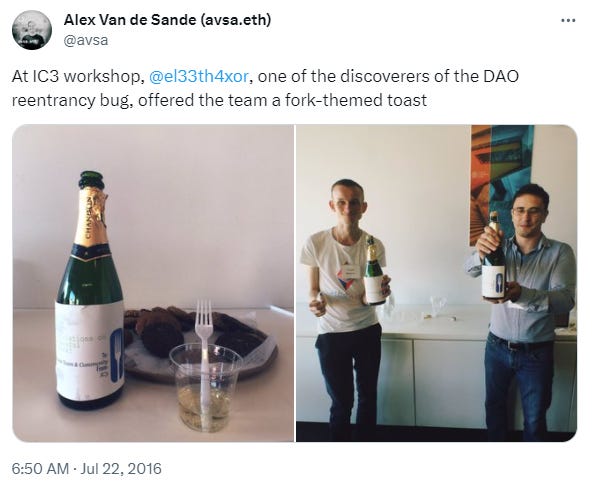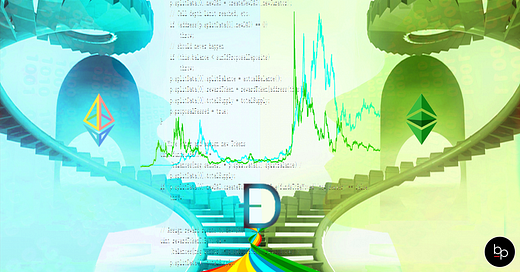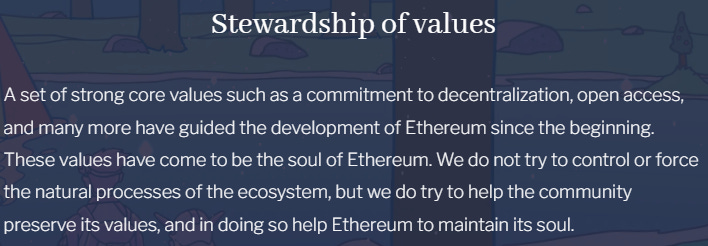Not Forking Around: The DAO Hack
The Critical Point in Ethereum's History Which Led to a Hard Fork
If you have your blockchain basics figured out, then you’ll be well aware that data recorded onchain are considered to be immutable. The reason for this is twofold: there are numerous copies of the data held across the nodes in a distributed network, and each data ‘block’ is cryptographically linked to the one recorded before it, meaning that no one can alter the ‘chain’ of data without significant and likely futile effort.
Any tampering or changes to the code without collective authorization of the community would be immediately evident. For a successful attack, a hacker would need to infiltrate a majority of computers on the network, all at the same time, in order to ensure they are all updated to the same hacked version. This would be nearly impossible, given that the system becomes more secure as the number of participants increases.
The DAO Controversy: The Case for a New Species of Corporate Governance?
Fork the Rules
But what happens when the community does ‘collectively authorize’ a change to the code? In 2016, in response to a smart contract exploit — now referred to as The DAO hack — influential members of the Ethereum community enacted a decision to alter not just transaction data but the underlying protocol. The dissent around this decision resulted in a fork of the blockchain.
A ‘fork’ is a term common in open-source software development which means to take a copy of the original software and take it in a new direction, with or without the blessing of the original code creator. There are two types of forks: hard and soft, with the difference defined by the level of compatibility with existing code:
Hard Fork
In a hard fork, the changes to the protocol are so substantial that nodes running older versions of the software are no longer compatible with the new version. In the context of blockchain, this results in a split, creating two separate blockchains.Soft Fork
A soft fork, on the other hand, involves minor rule changes, making it backward-compatible with older software versions. This means that the blockchain network remains unified, but the new rules become dominant. Soft forks are typically less contentious and disruptive than hard forks.
The decision to fork a blockchain is not taken lightly, but both hard and soft forks have happened with Ethereum and Bitcoin since their inception. Soft forks can occur for various reasons, including protocol upgrades and to patch security vulnerabilities, while, as with The DAO hack, hard forks typically result from ideological differences within the blockchain community.
The DAO Hack
Etched in the history of the Ethereum blockchain is the story of The DAO, and the ‘hack’ that occurred not long after its formation. The DAO was the first of its kind — a decentralized autonomous organization whose proposals, voted on by The DAO token holders, were executed via a set of smart contracts once the designated approval threshold was reached. Unlike many of today’s DAOs, The DAO’s founder remained anonymous and unknown even to the community, and governance was driven entirely by the code.
The DAO was formed as a decentralized investment fund that aimed to support various development projects on the Ethereum platform. In a relatively short time, it raised a vast amount of ether (ETH), making it one of the most significant crowdfunding efforts at the time. This article, written in May of 2016, says that $50 million worth of ether had been raised, but not long afterwards the figure reached $150 million.
In June 2016, an unknown token holder exploited a flaw in the DAO’s smart contract code which enabled them to transfer a substantial portion of the invested ETH — around $60 million worth — to themselves.

Some in the community felt this was a hack; others were adamant that ‘code is law’. The person responsible for the exploit commented publicly, noting in an open letter dated June 18, 2016:
I have carefully examined the code of The DAO and decided to participate after finding the feature where splitting is rewarded with additional ether. I have made use of this feature and have rightfully claimed 3,641,694 ether, and would like to thank the DAO for this reward. It is my understanding that the DAO code contains this feature to promote decentralization and encourage the creation of “child DAOs”.
I am disappointed by those who are characterizing the use of this intentional feature as “theft”. I am making use of this explicitly coded feature as per the smart contract terms.
The Dilemma
The Ethereum community was faced with a dilemma. There were those who argued that the blockchain’s immutability should be upheld, and transactions, even those caused by hacks, should remain irreversible. However, a significant portion of the community believed that such a major hack could undermine trust in Ethereum, and the stolen funds should be returned to their rightful owners by altering the underlying code.
After intense debate and discussion, the Ethereum community reached a consensus to perform an “irregular state change” which would essentially reverse the hack and return the stolen ETH. The Ethereum Foundation notes that the decision had 85% approval, yet some miners refused to accept the decision, saying the vote lacked neutrality, and continued on with the original Ethereum protocol.
The Decision
This decision led to the creation of two separate chains: Ethereum (ETH token), which continued with the hard-forked blockchain, and Ethereum Classic (ETC token), which remained on the original, unaltered chain. This article includes a helpful comparison of Ethereum and Ethereum Classic.
The exploiter of The DAO’s smart contract asserted in the open letter that the hard fork would be the downfall of Ethereum:
Such fork would permanently and irrevocably ruin all confidence in not only Ethereum but also the in [sic] the field of smart contracts and blockchain technology. Many large Ethereum holders will dump their ether, and developers, researchers, and companies will leave Ethereum. Make no mistake: any fork, soft or hard, will further damage Ethereum and destroy its reputation and appeal.
Yet it hasn’t quite turned out that way, at least if market cap and volume are anything to go by. Ethereum Classic has continued to operate with the original proof-of-work consensus, while Ethereum has since completed The Merge which successfully implemented proof-of-stake. Ethereum Classic proudly claims its OG status but struggles against community perception that it is “some sort of copy-cat project trying to cash in on ETH’s success”:
[M]any people may reasonably give Ethereum Classic a pass without much thought.
But some, like yourself, decide to dive a little deeper, and they discover some interesting facts that debunk that initial skepticism. Their journey down the rabbit hole begins when they find out that Ethereum Classic is not a clone of Ethereum™, but a continuation of the original Ethereum launched in 2015, which The Ethereum Foundation forked away from by launching a new protocol one year later in 2016.
Do Sour Grapes Stain?

Ethereum Classic’s website will tell you that it exists “in response to contract censorship on sister chain Ethereum™ (ETH) and to uphold and preserve the principle of Code is Law”. There is also a fascinating and detailed account of The DAO exploit on the Ethereum Classic website, which includes a statement that the hard fork was unnecessary because 70% of the funds had already been recovered using the same technique used to execute the original transfers:
The real “winners” of the vicious Hard Fork debate were the anti-forkers, who were proved right by the chain split and the return of recovered ETC, demonstrating that the Hard Fork wasn’t necessary.
It’s a thought-provoking read, given Ethereum’s growth since 2016, and the strong conviction shown by members of its community. While the authors of the account on the Ethereum Classic site acknowledge the two communities share the “same general ambition”, it’s clear that the split exposed an ideological rift. The Classic community believes the Ethereum Foundation used undue influence to achieve the hard fork in direct opposition to the values it purports to stand for.
Whether the fork has left an indelible stain on the reputation of the Ethereum Foundation and the supporters of the move is debatable, but the event certainly has an immutable place in blockchain history.
Author and Designer Bio
trewkat is a writer, editor, and designer at BanklessDAO. She’s interested in learning about web3, with a particular focus on how best to communicate this knowledge to others.
Editor Bio
Hiro Kennelly is a writer, editor, and coordinator at BanklessDAO, an Associate at Bankless Consulting, and is now and forever a DAOpunk.
BanklessDAO is an education and media engine dedicated to helping individuals achieve financial independence.
This post does not contain financial advice, only educational information. By reading this article, you agree and affirm the above, as well as that you are not being solicited to make a financial decision, and that you in no way are receiving any fiduciary projection, promise, or tacit inference of your ability to achieve financial gains.
Bankless Publishing is always accepting submissions for publication. We’d love to read your work, so please submit your article here!
More Like This
The Byzantine Generals Problem, 51% Attacks, and Proof-of-Work by Jake and Stake
Getting Smart About Smart Contract Vulnerabilities by Kornekt
Betting It All On Ethereum by Alphadegen.eth





